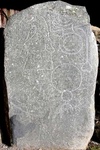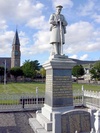| Rhynie 5 |
|---|

A class I Pictish stone made of gabbro showing a 'double disc and z rod symbol' with a symbol variously interpreted as a dog's head or as a mask made from the skin of a hind, accompanied by the mirror and comb regarded as a qualifying symbol. As with all Pictish Symbol stones dating is somewhat contentious. There are cup marks on the back of the stone suggesting Pictish re-use of a stone made significant in the Neolithic. Two other fragmentery stones, Rhynie 6 and 8, are at the same location. In all 8 symbol stones are known from Rhynie (suggesting a site of major importance) including the 'Rhynie Man' carving 7. Rhynie 4 has been broken up and lost, Rhynie 1 'The Craw Stane' is in situ 2 and 3 stand in the village sqare but their carving is now illegible to the human eye. More Information |
| Rhynie 6 |

A fragment of a class I Pictish stone made of pink granite the very bottom of a vertical double disc and Z rod can just be seen above a plain crescent and V rod and a mirror. Two other stones, Rhynie 5 and the fragmentery 8, are at the same location. In all 8 symbol stones are known from Rhynie (suggesting a site of major importance) including the 'Rhynie Man' carving 7. Rhynie 4 has been broken up and lost, Rhynie 1 'The Craw Stane' is in situ 2 and 3 stand in the village sqare but their carving is now illegible to the human eye. More Information |
| Rhynie War Memorial |

The granite war memorial stands in the middle of the square at Rhynie. It is rectangular in shape surmounted by a statute of a soldier standing on a stepped plinth. He is wearing a great coat and peeked cap, standing with bowed head and holding an inverted rifle. In front of the memorial is another plaque with the names of those killed in World War II. The memorial is surrounded by a wrought iron fence. Unveiled May 30th 1920. More Information |
| The Craw Stane (Rhynie 1) |

Class I Pictish symbol stone. The stone faces south it is a large stone 180cm by 102cm by 43cm. It has near the top a large Salmon symbol above a Pictish beast. It stands at one side of the inner entrance to an almost imperceptable (but clear in ariel photgraphs of crop marks) multi-vallate circular enclosure crowning the end of a low spur. It could possibly have been a structural feature re-used in situ as a symbol stone. More Information |
This content was submitted by external contributors and does not necessarily reflect the views of the University of Aberdeen.
